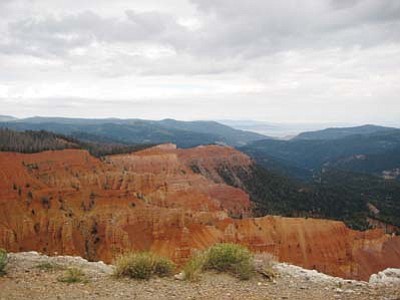'Natural highs' at Cedar Breaks National Monument
CEDAR CITY, Utah - Hopi High School teacher Skip Keith hiked Zion National Park this summer trekking through the treacherous Angel's Landing and the water-logged Narrows Trail.
Those running into Keith should ask him about the experience because he has a lot of cool stories.
However, those looking to avoid the summer construction, crowds and heat of Zion should look to Cedar Breaks National Monument and other points along Rt. 14, Rt. 148 and Rt. 143.
Panguitch Lake, Navajo Lake, Duck Pond and Duck Creek offer a lot of recreational opportunities with less of the crowds. Just don't go during winter because these destinations range from 7,500 to more than 10,000 feet in elevation, so some of these scenic highways are closed off during the winter because of the snow.
Cedar Breaks National Monument is literally one of the high points in Utah with Point Supreme topping out at 10,350 feet. This majestic landmark offers trails, flowers and a great view.
Cedar Breaks has two main trails. A circular two mile Alpine Pond Trail leads to a forest glade and pond. The two-mile Ramparts Trail along the plateau rim passes a stand of ancient bristlecone pines. Pets are not permitted on these two trails, but there is a trail that dogs can go on just to the right of the visitor center. There are also many places to stop along the five-mile drive taking motorists to overlooks and trailheads.
Flowers - including blue columbine, mountain blue bells, cinquefoil, shootingstar, fleabane, wild rose and Indian paintbrush - are abundant during the summer.
The natural amphitheater offers the great scenic rocks similar to Zion and Bryce. The amphitheater is more than 2,000 feet deep and more than three miles in diameter. Stone spires, columns, arches and canyons dot the amphitheater in reds, yellows and purples.
Birds include Clark's nutcrackers and violet green swallows. Mule deer, golden mantled ground squirrels, porcupines and red squirrels can also be seen.
Park service literature states that the Paiute were among the region's original residents. The Paiute called the area the umapwich or "the place where the rocks are falling down all the time."
A visitor center offers information, exhibits, books and gifts. A 28-site campground is open on a first-come, first served basis. For more information, call (435) 586-9451 or visit www.nps.gov/cbr.
The five miles inside the monument offer loads of meadows. Panguitch Lake is just another 20 miles down the road and the scenic drive offers more beautiful meadows.
Panguitch Lake is a natural 1,250 acre lake surrounded by lava flows and forest as well as some great looking summer homes and cabins. It was named by Paiute Indians with Panguitch meaning "Big Fish." Rainbow, brook, cutthroat and brown trout make this lake a fishing dream. Deer and elk are found at Panguitch Lake and the 8,400 feet altitude keeps it cool. Aspens, spruce and ponderosa pine dot the area.
Boating, horseback riding, air tours, biking and river running are among the entertainment features in the Panguitch Lake area.
On the way going or the way back, two great stops are Navajo Lake and Duck Pond.
Navajo Lake rests at 9,200 feet. The name came about when a Navajo raiding party and Cedar City cattlemen had a violent encounter in the 1800s.
Today, the peaceful area offers fishing, boating, hiking and biking.
The 3.5-mile-long lake was formed by a lava flow. The Navajo Lake Trail takes hikers and bikers 11.5 miles around the lake. The trail begins near the Te-Ah Campground, one of three campgrounds near Navajo Lake. Brook, splake and rainbow trout make this a good area for fishing.
Duck Creek Pond is aptly named with a multitude of ducks and birds visiting the scenic pond. Duck Creek Pond is right off of Rt 14 and Aspen Mirror Lake is about a half mile away.
Duck Creek Pond is up at 8,500 feet. Brook and rainbow trout are enough to keep those fishing happy. Butterflies are also abundant here and the streams from Duck Creek Pond run along Rt. 14 giving motorists plenty of places to stop.
There is a forest service campground and visitor center. Duck Creek Village is about four miles away. A store, a gas station and a motel are nearby.
SUBMIT FEEDBACK
Click Below to:




